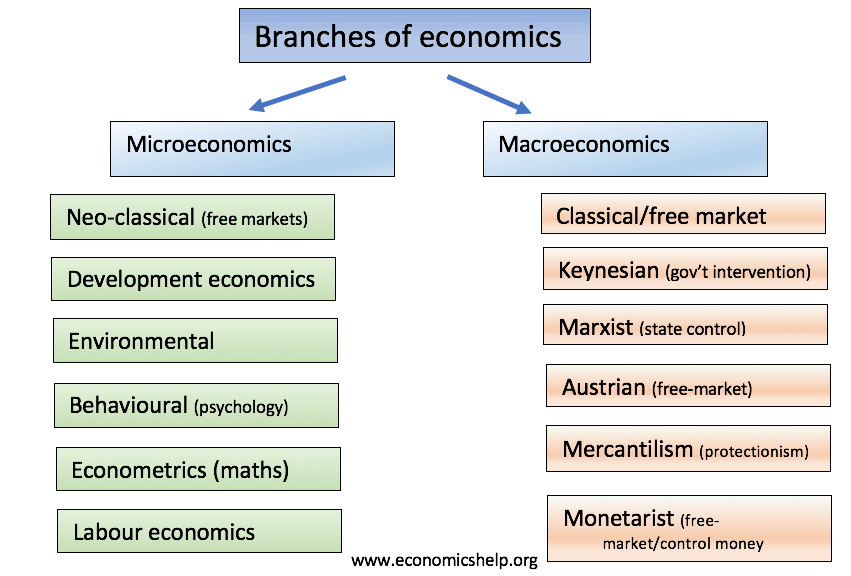Whereas macroeconomics is the study of a national economy as a whole. The Branches of the economy The most important are microeconomics macroeconomics international economics financial economics health education labor business agrarian ecological environmental and urban.

Two Main Branches Of Economic Analysis
Microeconomics can be considered as the ultimate cellular structure of THEORY economics.

. What their differences are. Microeconomics focuses on issues that affect individuals and companies. Keynesians and post-Keynesians follow the theories of John Maynard Keynes the most-celebrated.
Micro economics tends to work from theory first though this is not always the case. Microeconomics is the study of economics at an individual group or company level. Within the capitalist system the struggle between workers and capitalists is dominant.
Microeconomics is the study of individuals and business decisions while macroeconomics looks at the decisions of countries and governments. The economy Is the social science that is in charge of managing the resources of a certain area. Its Greek words that represent the etymology of the.
Humans are creative beings who realize their ideas through their work. The two major branches of economics are microeconomics and macroeconomics. The main difference is that micro looks at small segments and macro looks at the whole economy.
On the other hand Economy denotes the economic condition status and activities of a. Though these two branches of economics appear different. In a typical introductory microeconomics course.
On the other hand macroeconomics is the study of the whole economy. There are two divisions or branches of economics. Taking a critical approach it can be argued that ecological economics is more pluralist whereas environmental economics is based predominately on the thinking of neoclassical economics.
Micro Economics and Macro Economics. There are significant differences between the values that underpin these two schools of thought. Micro Economics and Macro Economics.
Two of the biggest camps are the Keynesians and the Monetarists. Macro-economics is perhaps the most divisive area of economics when applied to political decision making and macro-economists divide themselves into different schools of thought. Between rational and behavioural economics.
Here in the given article weve broken down the concept and all the important differences between microeconomics and macroeconomics in tabular. Macroeconomics focuses on issues that affect nations and the world economy. It looks at the issues like consumer behavior individual labor market and theory of firms.
These are called as Macroeconomics and Microeconomics. Microeconomics is a branch of economics that examines the market behavior of individual consumers and organizations. Differences between microeconomics and macroeconomics.
And between mainstream economics and heterodox economics. Positive economics describes what is while normative economics focus on what should be. Positive economics describes and explains various economic phenomena while normative economics focuses on the value of economic fairness or what the economy should be.
Microeconomics is the study of specific segments and markets of an economy. Business managers tend to focus on microeconomics and less focus on the macroeconomics while economists and policymakers tend to focus on macro and micro levels. Macroeconomic theory is a study of the behavior of the economy as a whole whereby the relationship is considered between broad economic aggregates such as national income employment and prices.
The fundamental difference between economics and economy is that Economics is a subject concerned with the optimization of available resources in an efficient manner. The subject-matter of economics has been divided into two parts. Between economic theory and applied economics.
The two major divisions of economics are macroeconomics and microeconomics. It focuses on the demand and supply pricing and output of individual organizations. This branch of economics is concerned about the level of production the rate of unemployment as well as in the gross national product and others.
Economics has been divided into two broad parts ie. Finally regardless of all the differences the role of the macro and micro economy and their importance should not be denied. The drive for private profit also leads to continuous technological advances and accompanying instability.
Economics is broadly divided into two different categories namely microeconomics and macroeconomics. Other broad distinctions within economics include those between positive economics describing what is and normative economics advocating what ought to be. On the other hand macroeconomics analyzes the economy as a whole.
Macroeconomics is the economics the deals with the behavior of the whole or entire economy. Microeconomics deals largely with the decision-making behavior of individual consumers and firms in markets while macroeconomics focuses largely on the aggregated behavior of all consumers and firms in an economy. Focuses on conflict and exploitation within economic systems.
Macroeconomics is the branch of economics that deals with the behavior of an entire community or country and microeconomics is the branch of economics that deals with the economic behavior of a specific segment. There are two broad categories into which Economics is classified ie. Macro economics places greater emphasis on empirical data and trying to explain it.
Sociology has slowly expanded its focus on other subjects such as health medicines military social stigma the system of control and role of social activity in human development.
Lesson 2 What Is Development Economics 1 Iau Office Of Astronomy For Development

Micro Economics Unit One The Nature Of Economics Ppt Download

0 Comments